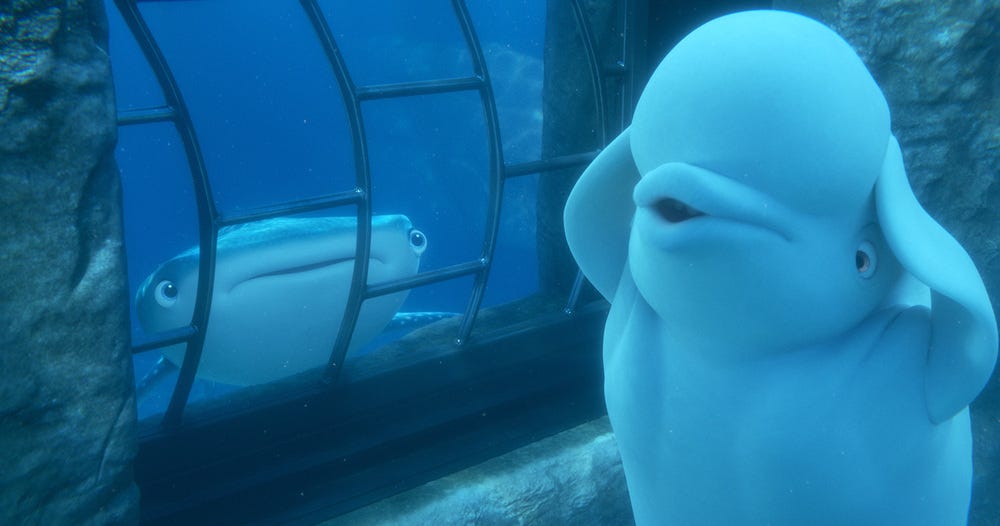Talking to the Animals — Is AI the New Doctor Dolittle?

Original Source Here
Talking to the Animals — Is AI the New Doctor Dolittle?
Researchers are venturing into uncharted waters, exploring whether artificial intelligence can help us better understand our animal cousins
If you’ve ever seen Finding Dory, the sweet and funny sequel to box-office hit Finding Nemo, you’ll know what it means to ‘speak whale.’ Without the help of a befuddled beluga whale called Bailey, the film’s forgetful fishy heroine would never escape the fictional Marine Life Institute and “just keep swimming” to find her long-lost parents.
Thanks to robotics and artificial intelligence (specifically natural language processing powered by machine learning), it might also be possible to understand whale lingo outside Disney-Pixar’s imaginary kaleidoscopic multiverse. In probably the most significant interspecies communication project of all time, researchers recently set about the titanic task of translating the Morse code-like series of clicks (or codas) used by sperm whales to chat with one another.
Cool, huh? And the results of Project CETI will no doubt be far more interesting than human discussions around the price of fish — or any other clever piscine reference you can think of.
As the ground-breaking five-year effort advances, I suspect a lot of people will follow closely — the prospect of pulling a genuine Dr Dolittle within our relatively short lifetime is beyond thrilling. But why? Why is the idea of accurately decoding the varied languages (if you can call them that) of other species so exciting?
For many, it likely bubbles down to a basic sense of curiosity, especially because the project involves a creature that lives in the sea — an environment mankind mostly perceives as dark and mysterious. Although a breakthrough in this pioneering research would certainly feed my own hungry spirit of inquiry, for me, success in interspecies communication is just as much about how we could transform the lives of our animal cousins (generally treated by people as second-class inhabitants of Earth) as it is about the human experience.
Projects like this (and, say, that time scientists used pattern-seeking algorithms to interpret different bat squeaks) may very well be the beginnings of a much-needed wake-up call for humanity — one that serves humans and animals equally.
We’re already relying on artificial intelligence systems from tech giants like Microsoft and Google in countless other ways to help the animal kingdom — like locating and removing plastic pollution from oceans and rivers and identifying, counting, and tracking wild animals. Researchers do this for the sake of crucial conservation work, both in a selfless effort to protect animals and a slightly more self-serving attempt to preserve Earth’s biodiversity and maintain the proper functioning of our natural ecosystems.
At the end of the day, the more species we lose, the greater the risk of an eventual ecological collapse, where our overall ecosystem suffers such an extreme reduction in its capacity to support life that we could face mass extinction. *Cue the Jaws theme song*
Instead of worrying that robots will one day rise up (annihilating mankind, forcing us to flee for Elon Musk’s colony on Mars, or making us bark on command), we should celebrate all the ways we’re using AI to save ourselves and the living, breathing creatures we share the planet with.
And we should definitely take the next logical step, exploiting the superb language talents of these technologies to improve the lives of animals even further. If researchers really can break the communication barrier, it’s a win-win scenario. We’d move beyond conservation projects like those mentioned above toward a stronger understanding of all types of creature (whether wild, domestic, or agricultural), giving them a meaningful opportunity to communicate their feelings and needs.
Of course, no whale could sit down and recite Moby Dick or share its thoughts on Free Willy (books and televisions don’t do so well 20,000 leagues under the sea, you know). However, whales and other species could tell us a thing or two about themselves in their own, unique ways — invaluable information we could only dream of gathering through other methods, such as observing behaviour.
To be fair, our relationship with animals over the past century has hardly been the best, so I’m up for anything that helps humanity atone for our cruel and environmentally unfriendly misdeeds. I just don’t want to know what cats think of us — I have a major hunch those crabby beasts would have little but insults to share!
AI/ML
Trending AI/ML Article Identified & Digested via Granola by Ramsey Elbasheer; a Machine-Driven RSS Bot
via WordPress https://ramseyelbasheer.io/2021/04/30/talking-to-the-animals%e2%80%8a-%e2%80%8ais-ai-the-new-doctor-dolittle/